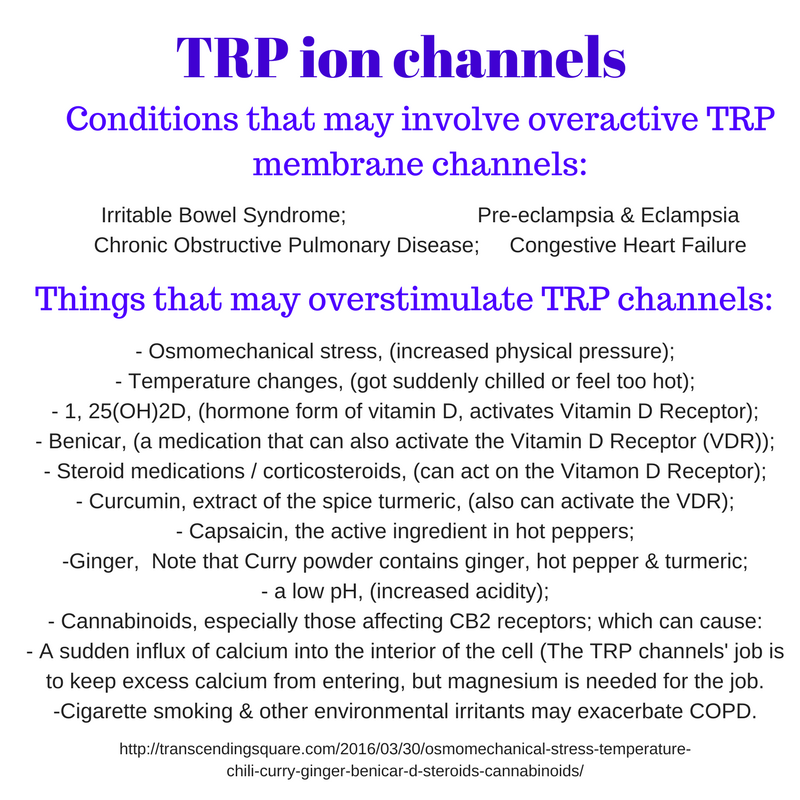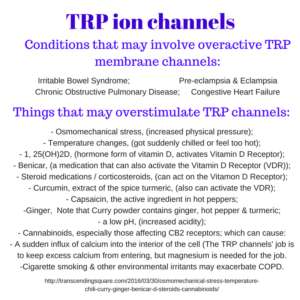Cinnamon, may help people with diabetes have better blood sugar control, (about 1/2 teaspoon per day which is quite a bit, try it stirred into hot breakfast cereal perhaps), however for people with a tendency to have migraines it may be a cause or become a cause if eaten regularly. Migraines can become more sensitized to things after long term use or certain chemicals can be triggers possibly due to overactivity of TRP ion channels.
Cinnamon contains the phytonutrient cinnamaldehyde which can activate TRPA1 channels. Environmental chemicals may also be irritants that can cause migraines due to activation of TRPA1 channels; including “environmental irritants and industry pollutants, such as acetaldehyde, formalin,(formaldehyde), hydrogen peroxide, hypochlorite, isocyanates, ozone, carbon dioxide, ultraviolet light, and acrolein (a highly reactive α,β-unsatured aldehyde present in tear gas, cigarette smoke, smoke from burning vegetation, and vehicle exhaust) [37–45]” (1) Older computer monitors may emit ultraviolet light but not modern laptops or smartphones. They do emit bluelight which may inhibit sleep. (2)
In the last post I mentioned that wearing blue light blocking glasses in the evening for any screen time. It has been found helpful to prevent sleep difficulties to wear them during the three hours prior to trying to go to sleep. The blue light blocking glasses are not needed for use throughout the day however. Eyestrain from a long day working with a light screen may cause dry itchy eyes and eyedrops for moisture and taking occasional breaks may help prevent that problem. Read more: (4).
The tip about keeping gel packs in the freezer for use as a cold compress for the forehead that I mentioned for insomnia in the last post is something that I have found helpful in the past for migraines. I tried it recently for insomnia after learning in the course about sleep and neurobiology that a “biothermal device” had been found helpful in sleep lab studies for patients with insomnia. (Sleep, Neurobiology, Medicine and Society, coursera.org)
The drawing suggested they had an electric blanket type compress size cooling device that laid over the forehead and slightly over the ear area, so a little bigger than a gel pack designed for sprained ankles. However a gel pack for sprained ankles is already at stores and electric cooling biothermal devices are not yet available to my knowledge. The point – my trial use with a freezer gel pack for insomnia was very helpful at slowing my thoughts and helping my body reach a relaxed state fairly quickly. I didn’t immediately go to sleep but it did seem to help. I’ve tried it several times now and one night got another out of the freezer when I was awake but sleepy in the middle of the night.
Throughout the history of science discoveries there have been many researchers who try things for themselves or discover things because of their own health issues or a patient with a unique problem. Migraines are very painful and medication can be expensive and may lead to rebound headaches when used too often – if migraines last three days and you have one twice a week than how helpful can four migraine pills a month be? Proper references for citing other’s work is important and the gel pack idea is one I tried based on the biothermal device idea. A different research team found a cooling plastic cap helpful for insomnia, which also sounds like it is based on some sort of cooling electric blanket effect. (gizmodo) Pain hurts and insomnia can increase risks for hypertension, diabetes, epileptic seizures, and also migraines.
Cinnamon, tasty, but not for me, it causes migraines for me. Read labels if you suspect it might be a migraine trigger, it may be added to herbal tea in addition to baked goods or breakfast cereals. Food triggers for migraines generally cause symptoms for me the next day or within 8-12 hours or so. Chemical irritants such as ozone, formaldehyde, or pollutants in cigarette smoke that are inhaled may cause migraines sooner, within a few hours or less sometimes for me. Additional information here: Tips for Avoiding Migraine Triggers, WebMD, getting adequate sleep is one of the tips.
Regarding TRPA1 channels and trigeminal pain sensing neurons – lots more to read later: trigeminal pain sensing neurons TRPA1 channels Substance P .
History note: Substance P was one of the first neuropeptides/ brain proteins discovered and it was initially purified in powder form and so was called Substance P for powder. (Neuropeptide Substance P and the Immune Response)
/Disclaimer: This information is provided for educational purposes within the guidelines of fair use. While I am a Registered Dietitian this information is not intended to provide individual health guidance. Please see a health professional for individual health care purposes./
- Benemei S, De Cesaris F, Fusi C, Rossi E, Lupi C, Geppetti P. TRPA1 and other TRP channels in migraine. The Journal of Headache and Pain. 2013;14(1):71. doi:10.1186/1129-2377-14-71. https://www.ncbi.nlm.nih.gov/pmc/articles/PMC3844362/
- Dustin Eves, Do Computer Screens Emit UV Light? techwalla.com, https://www.techwalla.com/articles/do-computer-screens-emit-uv-light
- Do Blue Light Blocking Glasses Really Work? 2018, nymag.com, http://nymag.com/strategist/article/blue-light-blocking-glasses-work.html
- Tips for Avoiding Migraine Triggers, WebMD, https://www.webmd.com/migraines-headaches/avoiding-migraine-triggers#1


